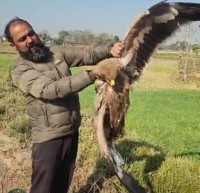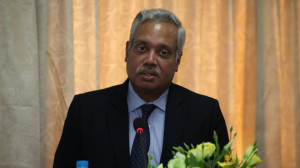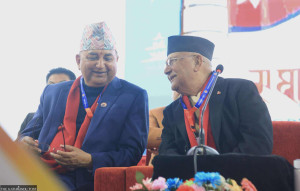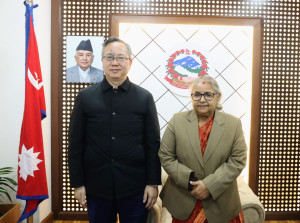National
Army for Covid response raises questions if government is getting over-reliant on the defence force
Government’s failure to make it clear why and on what grounds it is mobilising the Army may mean civilian authorities are ineffective and incompetent, analysts say..jpg&w=900&height=601)
Tika R Pradhan & Binod Ghimire
The government decision to deploy the Nepal Army for Covid-19 response has prompted many to question if the KP Sharma Oli administration is becoming over-reliant on the national defence force to deal with what civilian authorities should have been taking care of.
Though ministers have said a May 30 Cabinet meeting had decided to deploy the Army, they were not sure on what ground that decision was taken.
While some say the Army is being mobilised as per Article 267 (4), others say the move is pursuant to Article 267 (6).
According to a minister, the prime minister had told the meeting that the national defence force would be deployed as per Article 267 (6) of the constitution.
Article 267 (6) states that the President shall, on the recommendation of the National Security Council and pursuant to a decision of the government of Nepal, Council of Ministers, declare the mobilisation of the Nepal Army in cases where a grave emergency arises with regard to the sovereignty or territorial integrity of Nepal or security of any part thereof, by war, external aggression, armed rebellion or extreme economic disarray.
The Army mobilisation, then, must be ratified by the House of Representatives within one month after the date of such declaration.
No such declaration has, however, been made by the President.
One of the ministers present at the May 30 Cabinet meeting had told the Post that prior to the decision to deploy the Army in Covid-19 response, a meeting of the National Security Council was held.
Santa Bahadur Sunar, spokesperson for the Ministry of Defence, told the Post on Saturday that the May 30 Cabinet meeting had decided to deploy the Army as per the recommendation of the security council.
But since the Cabinet decision was not taken to the President’s Office for approval, government authorities believe that the Army could have been deployed as per Article 267 (4).
Article 267 (4) says the government can mobilise the army in development, construction and disaster management works.
Bhesh Raj Adhikari, an advisor to President Bhandari, said there are two different provisions for army deployment depending on the context and nature of the need.
“I believe the Army [in this case] has been mobilised as per Article 267 (4) of the statute,” Adhikari told the Post. “Since this is a new practice, some confusion seems to have arisen.”
But to invoke Article 267 (4), there is no need for the National Security Council to make a recommendation.
“The government through a Cabinet decision, as per Article 267 (4), can mobilise the Army in development works, construction, disaster and crisis management,” Brigadier General Bigyan Dev Pandey, spokesperson for the Nepal Army, told the Post.
According to Pandey, some 17,000 army personnel have been deployed across the country for Covid-19 response.
Security analysts and experts on constitutional matters say the government has failed to provide the rationale behind the deployment of the Army to respond to the Covid-19 pandemic and that there is a lack of clarity regarding the basis on which the defence force is being mobilised. If such moves are being made on arbitrary grounds, it means an admission that civilian authorities have failed, according to them.
“Three components are essential for the deployment of the Army as per the constitution—recommendation of the National Security Council, decision of the Cabinet and declaration by the President,” said Bhimarjuna Acharya, an expert on constitutional law. “Without the declaration from the President, army deployment is tantamount to non-compliance with the constitution.”
Even as the Oli administration claims to be doing all it can to fight the Covid-19 pandemic, it is yet to declare the situation a “disaster or crisis.”
The Oli administration lately appears to have been overly relying on the Army, as it has been roping in the defence force even for tasks that could have been easily carried out by civilian authorities.
After a controversy over the medical equipment procurement in April, the government swiftly decided to bring the Army to carry out the task under a government-to-government deal, inviting criticism from various sections.
Even though the government had said the Army was entrusted with the task of fast-tracking the procurement process, it took around two months for it to bring in the supplies. It brought the equipment and medical kits through air and land routes last week.
Geja Sharma Wagle, who writes extensively on security matters and follows national security issues, said the government has not made it clear on which ground the Army has been deployed and hence the move appears to be suspicious.
“Even if the Army was deployed as per 267 (4), it needs to pass through the President,” Wagle told the Post. “Deploying the Nepal Army is not like the Home Ministry deploying the Nepal Police and the Armed Police Force.”
According to Wagle, such practice could set a wrong precedent, as the government could deploy the defence force anytime and anywhere, avoiding both Parliament and the President.
During a consultative meeting with around two dozen experts on Wednesday, the prime minister had taken a strong position on the deployment of the Army, according to a participant.
“The Army is afterall one of the organs of the state, so its deployment in combating the crisis should not be taken otherwise,” the participant quoted the prime minister as telling the group of experts.
Even some ruling party leaders and lawmakers have expressed their displeasure at the way the government has kept its decisions, including the army mobilisation, in the dark.
“The government cannot keep the people in the dark about its important decisions,” said Ram Narayan Bidari, a National Assembly member from the ruling party.
Opposition party leaders say an elected government leaning on the Army all the time raises questions over the competence of the civilian authority.
“It’s not good to abdicate the responsibilities of the civilian authority to institutions like the Army and constitutional bodies like the Commission for Investigation of Abuse of Authority,” said Radheshyam Adhikary, a member of the National Assembly from the Nepali Congress. “This shows that the civilian government is failing to function.”
It is not that the Army has not been carrying out other tasks that should be taken care of by civilian authorities. The Army, which is currently constructing the Kathmandu-Nijgadh expressway, was tasked with building homes for tornado victims in Bara in April last year.
Security analysts say the concern is rather over the intent and the process and that increasing reliance on the defence force by a civilian government does not bode well for democractic systems.
“The state can deploy the Army during a time of disaster, but sudden and haphazard decisions to use them for tasks like procurement, quarantine management and transporting people show that all other civilian organs of the state are either ineffective or incompetent,” said Wagle. “This also shows that the Nepal Army is the only remaining institution capable of resolving all the problems and managing things.”
Since the Covid-19 pandemic hit the country, the government has formed at least two committees to chalk out plans to fight the disease—high-level coordination committee to prevent and control Covid-19 and the Corona Crisis Management Centre.
According to officials familiar with the decision-making in the two committees, though both of them are led by Defence Minister Ishwar Pokhrel, PM Oli prevails on almost all occasions.
Apart from these two recently set up committees, there are at least three different disaster management bodies in place with their own structures, acts and jurisdictions—the Disaster Management Authority led by the prime minister, Disaster Management Committee led by the home minister and 77 district committees led by the respective chief district officer.
“But the government has ignored all these existing civilian structures and set up the Corona Crisis Management Committee with an aim to hand over the responsibility to the Army, which is a fundamental weakness and problem of the civilian authority,” said Wagle. “This move has raised serious questions about the intention of the government.”




 17.12°C Kathmandu
17.12°C Kathmandu















